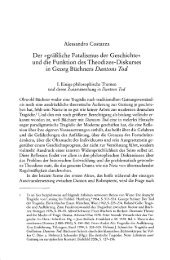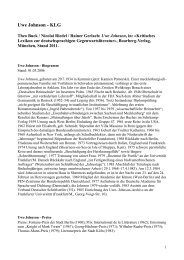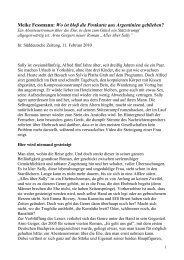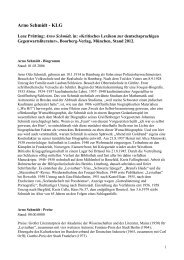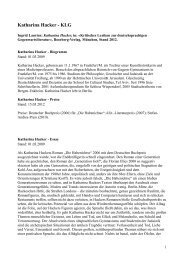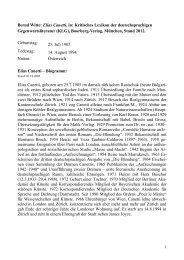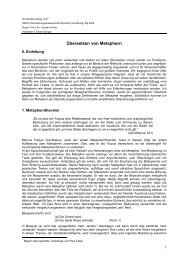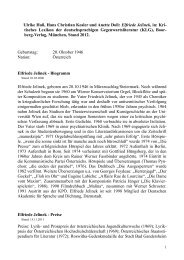Current Opinion in Investigational Drugs
Current Opinion in Investigational Drugs
Current Opinion in Investigational Drugs
You also want an ePaper? Increase the reach of your titles
YUMPU automatically turns print PDFs into web optimized ePapers that Google loves.
2 <strong>Current</strong> <strong>Op<strong>in</strong>ion</strong> <strong>in</strong> <strong>Investigational</strong> <strong>Drugs</strong> 2006 Vol 7 No 1<br />
predicted to become a major challenge for healthcare providers,<br />
especially as the currently asymptomatic carriers of this virus<br />
may develop hepatocellular carc<strong>in</strong>oma. Furthermore, the death<br />
rate due to HCV <strong>in</strong>fection is predicted to triple <strong>in</strong> the next ten to<br />
20 years. <strong>Current</strong> treatment protocols <strong>in</strong>volve either the<br />
adm<strong>in</strong>istration of <strong>in</strong>terferon (IFN)α or its pegylated form alone<br />
or <strong>in</strong> comb<strong>in</strong>ation with ribavir<strong>in</strong> (RBV). IFNα causes<br />
neuropsychiatric adverse effects and anemia is the most<br />
common side effect of RBV. In addition, the response rate for<br />
both therapeutic approaches is < 50%. Thus, the identification<br />
of new and effective drugs for the treatment of HCV <strong>in</strong>fection is<br />
critical. These researchers previously identified a novel<br />
compound, N 3,5'-cyclo-4-(β-D-ribofuranosyl)-vic-triazolo[4,5b]pyrid<strong>in</strong>-5-one<br />
(CRTP), which exhibited moderate anti-HCV<br />
activity <strong>in</strong> a subgenomic RNA replicon system. In an effort to<br />
discover more potent anti-HCV agents, a series of 6- and 7substituted<br />
derivatives of CRTP were synthesized. In this<br />
study, different 5-thiono, 6-halo, 7-alkylam<strong>in</strong>o and 7-methyl<br />
analogs of CRTP were synthesized and their anti-HCV activity<br />
and cytotoxicity evaluated. Some of the newly synthesized<br />
compounds exhibited 8- to 40-fold more potent anti-HCV<br />
activity than that of CRTP.<br />
F<strong>in</strong>d<strong>in</strong>gs CRTP was <strong>in</strong>itially synthesized from 1-(2,3,5-tri-Obenzoyl-β-D-ribofuranosyl)-5-nitropyrid<strong>in</strong>-2-one<br />
us<strong>in</strong>g either<br />
a five-step traditional synthetic method or a one-pot<br />
synthetic method. Further synthetic procedures <strong>in</strong>volv<strong>in</strong>g<br />
CRTP resulted <strong>in</strong> 5-thiono, 6-chloro/bromo, 7-am<strong>in</strong>o or 7alkylam<strong>in</strong>o<br />
analogs. The 7-methyl analog of CRTP was<br />
prepared us<strong>in</strong>g a different methodology. The synthesized<br />
compounds were tested for their ability to <strong>in</strong>hibit HCV RNA<br />
<strong>in</strong> a subgenomic replicon Huh-7 cell l<strong>in</strong>e. Cytotoxicity was<br />
determ<strong>in</strong>ed us<strong>in</strong>g an MTS assay. Among the compounds<br />
tested, the 5-thiono, 6-chloro, 6-bromo, 7-am<strong>in</strong>o, 7methylam<strong>in</strong>o<br />
and 7-methyl analogs exhibited more potent<br />
anti-HCV activity than CRTP, with the 6-chloro and 6-bromo<br />
analogs be<strong>in</strong>g the most potent. This study suggests a direct<br />
correlation between the anti-HCV activity and the<br />
cytotoxicity of these compounds.<br />
Endocr<strong>in</strong>e & metabolics<br />
Selected by Mariano J Elices (PharmaMar USA, Cambridge,<br />
MA, USA)<br />
Normal fast<strong>in</strong>g plasma glucose levels and type 2<br />
diabetes <strong>in</strong> young men.<br />
Tirosh A, Shai I, Tekes-Manova D, Israeli E, Pereg D, Shochat<br />
T, Kochba I, Rudich A; Israeli Diabetes Research Group<br />
(Medical Corps Headquarters, Tel-Hashomer, Israel).<br />
N Engl J Med (2005) 353(14):1454-1462.<br />
• Significance Science textbooks generally list the range of<br />
fast<strong>in</strong>g plasma glucose values for healthy <strong>in</strong>dividuals<br />
(normoglycemic) as be<strong>in</strong>g 70 to 110 mg/dl. However, <strong>in</strong><br />
2003, an expert committee at the American Diabetes<br />
Association (ADA) revised this long-held view and<br />
suggested that fast<strong>in</strong>g blood glucose levels of 101 to 109<br />
mg/dl represent impairment of glucose metabolism and<br />
thus pose a risk for the development of type 2 diabetes. In<br />
general, the <strong>in</strong>cidence of type 2 diabetes has <strong>in</strong>creased <strong>in</strong><br />
developed countries, <strong>in</strong>clud<strong>in</strong>g among younger members of<br />
the population that have traditionally not been considered to<br />
be at risk; thus it is of significant value to uncover risk<br />
factors for this illness.<br />
F<strong>in</strong>d<strong>in</strong>gs In order to address which risk factors contribute to<br />
the development of type 2 diabetes, the <strong>in</strong>vestigators exam<strong>in</strong>ed<br />
a computerized database that was established <strong>in</strong> 1992 to<br />
capture data from the MELANY (MEtabolic, Lifestyle, And<br />
Nutrition assessment <strong>in</strong> Young adults) trial. This trial was<br />
conducted among military personnel over 25 years of age <strong>in</strong><br />
Israel who received periodic exam<strong>in</strong>ations every three to five<br />
years. At the time of their periodic visit, each <strong>in</strong>dividual gave a<br />
blood sample after a 14-h fast<strong>in</strong>g period, and received a medical<br />
exam<strong>in</strong>ation; a detailed questionnaire was also completed by<br />
each <strong>in</strong>dividual. The primary endpo<strong>in</strong>t of the study was a new<br />
diagnosis of type 2 diabetes dur<strong>in</strong>g the trial (based on criteria<br />
outl<strong>in</strong>ed by the ADA expert committee) which <strong>in</strong>volved the<br />
record<strong>in</strong>g of two fast<strong>in</strong>g plasma glucose levels of at least 126<br />
mg/dl. Of 13,163 male <strong>in</strong>dividuals with fast<strong>in</strong>g blood glucose<br />
levels of ≤ 100 mg/dl, there were 208 new cases of type 2<br />
diabetes (ie, a 1.6% <strong>in</strong>cidence) spann<strong>in</strong>g an average of 5.7 years<br />
of follow-up. Multivariate models showed that males with<br />
fast<strong>in</strong>g blood glucose at the high end of the normal range (91 to<br />
99 mg/dl), comb<strong>in</strong>ed with serum triglyceride levels of ≥ 150<br />
mg/dl, had an 8.23-fold higher risk of develop<strong>in</strong>g type 2<br />
diabetes compared with <strong>in</strong>dividuals with fast<strong>in</strong>g plasma<br />
glucose and serum triglyceride levels of ≤ 86 and < 150 mg/dl,<br />
respectively. In a similar manner, hazard ratios revealed a 8.29fold<br />
higher risk of develop<strong>in</strong>g type 2 diabetes <strong>in</strong> obese men<br />
(body mass <strong>in</strong>dex ≥ 30) even when they had a normal, albeit<br />
high, fast<strong>in</strong>g blood glucose (91 to 99 mg/dl), compared with<br />
control <strong>in</strong>dividuals with fast<strong>in</strong>g plasma glucose levels and a<br />
body mass <strong>in</strong>dex of ≤ 86 mg/dl and < 25, respectively. These<br />
data strongly suggest that normoglycemic <strong>in</strong>dividuals with<br />
either serum triglyceride levels > 150 mg/dl or exhibit<strong>in</strong>g<br />
relative obesity (ie, body mass <strong>in</strong>dex ≥ 30) are at an <strong>in</strong>creased<br />
risk of develop<strong>in</strong>g type 2 diabetes later <strong>in</strong> life. From a healthcare<br />
standpo<strong>in</strong>t, these f<strong>in</strong>d<strong>in</strong>gs expose a host of opportunities <strong>in</strong><br />
diagnostic, preventive and therapeutic areas <strong>in</strong> type 2 diabetes.<br />
Oncological<br />
Selected by Robert E Hurst (Oklahoma University Health<br />
Sciences Center, OK, USA)<br />
A potential synergistic anticancer effect of paclitaxel<br />
and amifost<strong>in</strong>e on endometrial cancer.<br />
Dai D, Holmes AM, Nguyen T, Davies S, Theele DP,<br />
Verschraegen C, Leslie KK (University of New Mexico Health<br />
Sciences Center, Albuquerque, NM, USA).<br />
Cancer Res (2005) 65(20):9517-9524.<br />
• Significance Although the prognosis for endometrial cancer<br />
is generally good, advanced or recurrent cases have a poor<br />
prognosis, with chemotherapy offer<strong>in</strong>g mostly palliative<br />
therapy. Amifost<strong>in</strong>e has been proven to protect normal cells<br />
aga<strong>in</strong>st a number of chemotherapeutic agents, <strong>in</strong>clud<strong>in</strong>g<br />
paclitaxel. Amifost<strong>in</strong>e not only allows the adm<strong>in</strong>istration of<br />
higher doses of paclitaxel but, <strong>in</strong> this study, the drug also had a<br />
direct effect on endometrial cancer cells, and acted<br />
synergistically with paclitaxel. Thus, comb<strong>in</strong>ation therapy<br />
with these two drugs may be more effective than paclitaxel<br />
alone.




